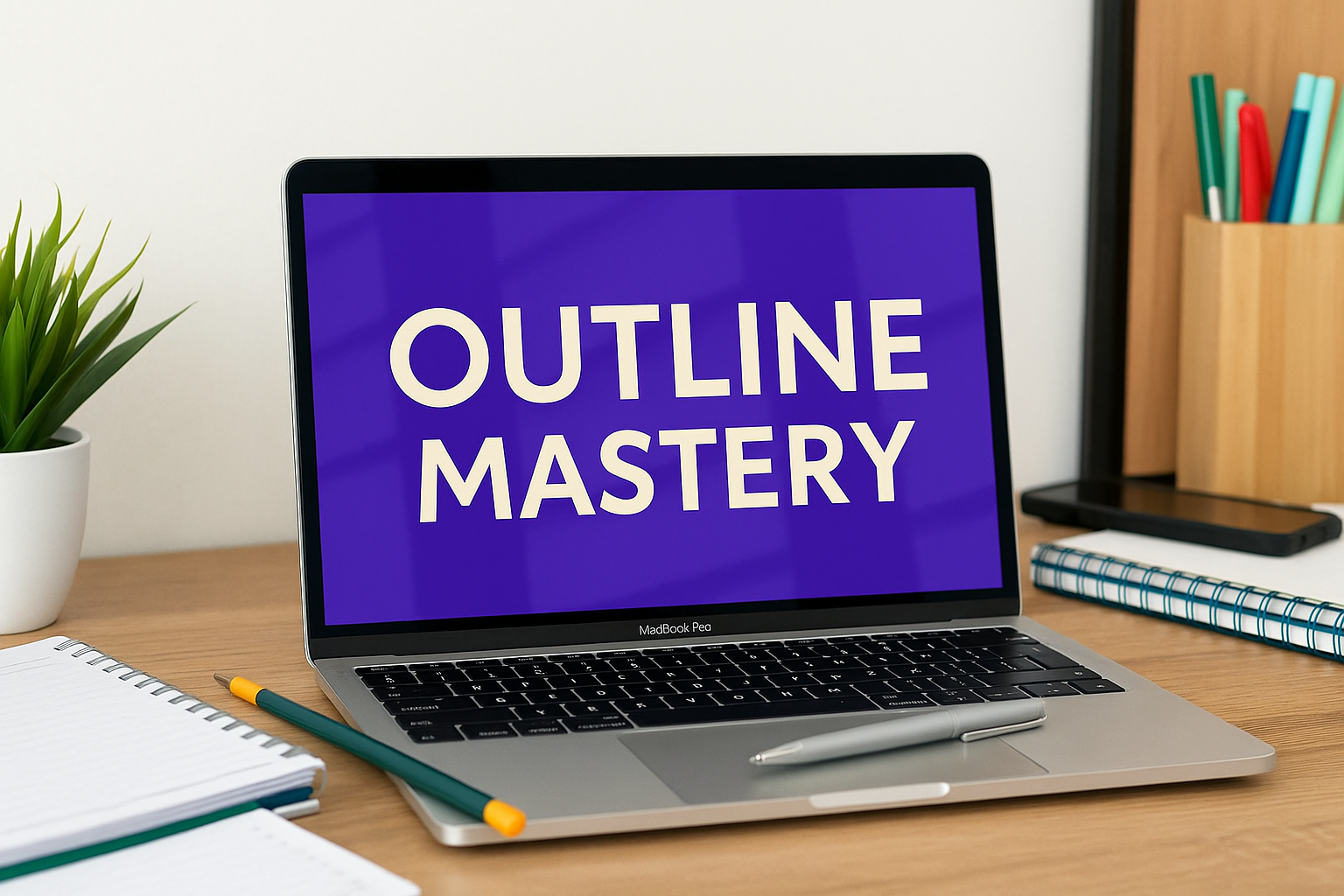Why Effective Training Outline Formats Transform Learning
A well-structured training outline format is the foundation of any successful learning experience. It's like an architect's blueprint; without a solid plan, the final structure risks being weak and ineffective. This applies to any training scenario, from onboarding new hires at your Shopify store to teaching intricate technical skills or introducing new products to your sales team.
Effective training outlines go beyond a simple list of topics. They're strategically crafted to boost knowledge retention and learner engagement. They guarantee a logical flow of information, building upon previous concepts to create a cohesive learning journey.
For example, a training program on using Tevello to integrate courses within a Shopify store could begin with a platform overview, then move to course setup, and finally, delve into marketing tactics. This structured approach allows learners to absorb and apply the information effectively.
A strong training outline also promotes clear communication and sets shared expectations. It guides both the facilitator and participants, ensuring everyone is aligned. This clarity minimizes confusion and disruptions, fostering a focused and productive learning environment. It also simplifies the adaptation of existing modules and provides a clear path for customizing training for specific audiences.
Creating a robust training outline is essential for businesses today. A key tool in this process is a Learning Management System (LMS). Approximately 16.9% of companies worldwide use an LMS, highlighting the growing trend towards standardized learning. This shift toward digital platforms reflects the increasing demand for efficient and scalable training solutions. For example, a training outline template can streamline the employee training experience by giving trainees a roadmap that emphasizes key objectives.
By integrating digital tools, companies can ensure continuous learning and adaptability – critical needs in today’s business world. Recent data shows that 70% of employees prefer online or self-paced courses, emphasizing the importance of flexible learning. Learn more about employee training statistics. Using detailed training outlines to tailor these programs can dramatically improve employee engagement and productivity. This trend toward structured learning underscores the vital role of well-designed training outlines.
The Impact of a Poorly Defined Training Outline
Conversely, training without a well-defined structure can lead to numerous problems. Inconsistent delivery, difficulty tracking progress, and reduced learner motivation are common outcomes when the training outline format is neglected. This can result in wasted resources, a lower return on investment, and ultimately, failure to achieve the desired training goals. A weak outline can mean missing key concepts, confusing learners about objectives, or failing to address the audience's specific needs.
Key Benefits of a Well-Structured Training Outline
A strong training outline offers a multitude of advantages:
- Improved Knowledge Retention: A logical flow of information promotes better comprehension and recall.
- Increased Learner Engagement: A structured outline helps maintain learner focus and motivation.
- Consistent Delivery: It ensures consistent coverage of all key points across various sessions.
- Measurable Results: A clear outline simplifies progress tracking and training effectiveness evaluation.
- Adaptability: A well-structured format easily adapts to different learning styles and audience needs.
By prioritizing the training outline format, businesses and educators can create more engaging and effective learning experiences that yield tangible results.
Core Elements That Make Training Outline Formats Shine

Effective training outlines are more than just bulleted lists; they're the blueprints for impactful learning. This section explores the key components of a successful training outline format, ensuring your program not only delivers information effectively but also fosters a positive learning environment. This foundation is key to achieving your training goals.
Defining Crystal-Clear Learning Objectives
Learning objectives are the compass of your training program. They pinpoint precisely what participants should be able to do upon completion. These objectives should be SMART: Specific, Measurable, Achievable, Relevant, and Time-Bound.
For example, instead of a broad objective like "understand project management," a SMART objective would be "create a project plan with defined milestones and resource allocation within two hours." Well-defined objectives guide content creation and assessment design, ensuring everything contributes to the desired results.
Strategic Content Sequencing: Building Confidence and Competence
The order you present information significantly influences learner comprehension. Start with fundamental concepts and gradually progress to more complex material. This structured approach allows learners to absorb and apply knowledge effectively, much like building a house brick by brick.
A logical flow builds confidence and encourages continued engagement. This makes even challenging topics feel manageable and promotes a sense of accomplishment.
Realistic Time Allocation: Respecting Adult Learners
Effective time management is crucial. Adult learners often have limited time and value focused sessions. Structure your content into digestible segments with realistic timeframes for each activity. This acknowledges their busy schedules and promotes focused engagement.
Remember to include ample time for practice and application. This reinforces learning and allows participants to solidify new skills.
Integrating Diverse Delivery Methods: Engaging All Learners
Using various delivery methods caters to different learning styles and keeps participants actively involved. Consider a mix of lectures, discussions, group activities, hands-on exercises, and multimedia presentations. This variety caters to diverse learning preferences and maintains momentum, particularly during extended training sessions. This also keeps the learning experience dynamic and stimulating. Looking for inspiration? Check out these top HR Training Programs for ideas.
Building Meaningful Assessment: Measuring Training Impact
Assessment isn't an afterthought; it's an integral part of your training outline. Integrate assessment strategies from the beginning to measure learning and identify areas for improvement. This might involve pre-tests, quizzes, and post-tests to evaluate knowledge gain.
Assessment helps track progress and demonstrate the effectiveness of your training program. This data-driven approach ensures your training is both engaging and demonstrably valuable. For more guidance, explore best practices for online course development in our comprehensive guide: Best Practices for Online Courses. Careful planning leads to successful and measurable results.
To further illustrate these core components, let's examine them in a comparative table format:
Core Components of Training Outline Formats
A comprehensive comparison of essential elements that should be included in different types of training outline formats
| Outline Component | Purpose | Best Practice Example | Common Pitfall |
|---|---|---|---|
| Learning Objectives | Define what participants should achieve | "Be able to create a project plan with milestones and resource allocation within 2 hours" | Vague objectives like "Understand project management" |
| Content Sequencing | Structure information for optimal comprehension | Gradual progression from basic to advanced concepts | Presenting complex information too early |
| Time Allocation | Maximize learning within given timeframes | Allocate realistic time for each activity, including practice | Overloading sessions with too much content |
| Delivery Methods | Cater to different learning styles and maintain engagement | Blend lectures, discussions, hands-on activities, and multimedia | Relying solely on one delivery method |
| Assessment | Measure learning and identify areas for improvement | Integrate pre-tests, quizzes, and post-tests | Treating assessment as an afterthought |
This table highlights the importance of each element in creating a well-structured training outline. By addressing each component effectively, you can ensure a more impactful and engaging learning experience. Remember that clear objectives, thoughtful sequencing, realistic timing, diverse delivery methods, and integrated assessment are the cornerstones of successful training.
Training Outline Format Templates That Actually Work

Tired of starting from scratch with every training program? This section provides effective training outline templates for diverse needs, from technical skills training to leadership development. Each template includes explanations of why specific elements enhance learning, alongside real-world examples from organizations that excel in training design.
Understanding the Importance of Templates
A good training outline format is like a roadmap, guiding both the trainer and trainees. Using a template ensures consistency and provides a solid structure to build upon. This is particularly beneficial for organizations conducting frequent training sessions, as it helps maintain quality and efficiency. This approach also makes training more scalable and repeatable, even with different facilitators.
Sample Training Outline Format for Technical Skills Development
This template prioritizes practical skill development by breaking complex tasks into smaller, more digestible steps.
-
Module 1: Introduction (1 hour)
- Course Overview
- Learning Objectives
- Icebreaker Activity
-
Module 2: Foundational Concepts (2 hours)
- Theory Explanation
- Practical Examples
- Quiz
-
Module 3: Hands-on Practice (3 hours)
- Guided Exercises
- Individual Projects
- Group Problem-Solving
-
Module 4: Advanced Techniques (2 hours)
- Specialized Skill Demonstration
- Case Study Analysis
- Q&A Session
-
Module 5: Wrap-up and Next Steps (1 hour)
- Review of Key Concepts
- Action Planning
- Feedback and Evaluation
This structured method facilitates a seamless transition from theory to practice, accommodating different learning styles. The "hands-on practice" module, for instance, reinforces learned concepts through real-world application. You might also find value in exploring online course creation: Creating Online Courses - Expert Tips for Success. Now, let's consider a different training focus.
Sample Training Outline Format for Leadership Training
This template emphasizes soft skills and strategic thinking, critical for effective leadership.
-
Day 1: Vision and Strategy (6 hours)
- Defining Leadership
- Vision Setting
- Strategic Planning Activity
- Group Discussion
-
Day 2: Communication and Influence (6 hours)
- Effective Communication Techniques
- Influencing Without Authority
- Role-Playing Scenarios
- Feedback and Coaching
-
Day 3: Team Building and Collaboration (6 hours)
- Building High-Performing Teams
- Conflict Resolution Strategies
- Team Project
- Presentation and Evaluation
This format promotes active participation and thoughtful reflection, essential for leadership development. This is particularly valuable in today's fast-paced business environment, which often requires quick decision-making and adaptability. Incorporating real-world scenarios and case studies helps translate these skills into practical application.
Adapting Templates to Different Contexts
These templates are adaptable and designed to be modified. Skilled trainers adjust them based on factors like available time, the audience's specific needs, and the chosen delivery method. A training session for senior professionals, for example, will differ significantly from training designed for entry-level employees.
Creating a compelling training summary is crucial for communicating the training’s value. A well-crafted summary includes clear objectives, key takeaways, participant feedback, and actionable recommendations. Consider these statistics: 85% of companies with over 50 employees provide formal training, demonstrating the recognized importance of structured learning. Additionally, 54% of employees prefer personalized training paths, often facilitated by digital platforms like an LMS. Strong training summaries improve knowledge retention and application, highlighting the importance of well-designed training outlines. Find more detailed statistics here. This inherent flexibility makes these templates highly effective, providing a reliable foundation while allowing for customization to maximize impact.
Digital Tools That Revolutionize Training Outline Design

Training outlines have come a long way. We've moved past static documents and embraced dynamic, interactive learning experiences. Digital tools are driving this shift, giving learning professionals more power to create and refine training frameworks. These tools offer a range of features, from collaborative development to content generation, changing how we approach training. This evolution is essential for meeting the evolving needs of both businesses and learners.
Learning Management Systems: Beyond Content Delivery
Learning Management Systems (LMS) are more than just content delivery platforms. Leading organizations now use them as central hubs for building training outlines collaboratively. This allows subject matter experts, instructional designers, and facilitators to work together seamlessly.
For example, an LMS can manage version control, feedback, and real-time updates to the training outline. This streamlined approach keeps everyone aligned and contributes to a more cohesive final product. You might be interested in: Top Learning Management Systems 2025 Review. Furthermore, an LMS can track the effectiveness of different outline versions, providing valuable data insights for continuous improvement.
AI-Assisted Tools: Enhancing Efficiency and Maintaining the Human Touch
Artificial intelligence (AI) plays a growing role in training outline design. AI-powered tools can help trainers generate outline components based on learning objectives and audience profiles. This automation saves time, allowing trainers to focus on more creative and strategic design elements.
The human element is still vital, though. While AI can automate tasks, trainers must ensure the outline retains a human touch to drive engagement. Trainers should curate and refine AI-generated content, adding their expertise and tailoring the outline to specific learning needs. This blend of AI and human input makes for powerful and effective training. This balance ensures materials are both efficient and engaging.
Selecting the Right Digital Tools: Aligning With Organizational Needs
The abundance of digital tools can be overwhelming. When selecting tools for training outline design, consider your organization's specific needs, limitations, and growth plans. A small startup might prioritize affordable, user-friendly tools, while a larger enterprise might need more advanced features for complex training programs.
Chosen tools should also integrate smoothly with existing systems and workflows. A fragmented technology stack can reduce efficiency and create unnecessary complexity. A well-integrated system, however, streamlines the entire training process from outline creation to delivery and evaluation. Choosing the right tools is a smart long-term investment.
In terms of official statistics, the demand for structured training has grown quickly, influenced by online courses and webinars. The pandemic accelerated this trend, making global data comparability a key concern. This has led to a greater focus on international training cooperation, particularly in developing universal methodologies. For instance, the Statistical Journal of the IAOS emphasizes harmonizing training methods for official statisticians in both local and global contexts. These efforts highlight the need for well-structured training outlines to ensure consistency and efficiency in statistical practices worldwide. Explore this topic further. This demonstrates the importance of adapting training methods to our increasingly interconnected world.
Technology Integration: Creating Seamless Workflows
Integrating technology into training outline design creates smooth workflows from planning to delivery and evaluation. This integration enhances communication and collaboration among team members, keeping everyone aligned. Imagine a team developing a new product training program. Using a collaborative platform, product managers can share updates directly within the training outline, keeping the content current in real time.
This dynamic approach allows for continuous feedback and iteration, resulting in more agile and responsive training programs. Data analytics from the LMS can also offer valuable insights into learner engagement and performance. This allows data-driven adjustments to the training outline for optimal results. This ongoing improvement process ensures training remains relevant and impactful.
Customizing Training Outline Formats For Your Audience
Generic training programs often fall short of expectations. This section explores how to tailor your training outline format to truly connect with your audience. We'll delve into how seasoned trainers adapt their methods based on audience demographics, existing knowledge, and learning style preferences. This ensures the training is both relevant and captivating for everyone involved.
Adapting to Different Generations
Different generations have unique learning styles. Baby Boomers may appreciate detailed handouts and structured presentations, while Gen Z learners often thrive in interactive, tech-focused settings. Adapting your training outline format to these preferences is crucial for optimizing engagement and knowledge retention across all age groups.
For example, incorporating more visual aids and interactive exercises can be highly effective for younger audiences. Conversely, providing comprehensive summaries and opportunities for reflection can greatly benefit more experienced learners.
You don't need entirely separate programs. Minor tweaks can yield substantial results. Offering both digital and printed materials can cater to diverse preferences within a single group. Similarly, incorporating a variety of learning activities, from group discussions to individual projects, can accommodate diverse learning styles.
Building Flexibility Into Your Training Outline Format
The ability to adapt and incorporate new information is essential for training programs. Your training outline should be flexible enough to accommodate emerging needs without compromising the core objectives. This adaptability is critical for addressing current industry trends and ensuring the training remains relevant and valuable.
Think of your training outline as a guiding framework, not a rigid script. Integrate opportunities for open discussions, Q&A sessions, and real-time problem-solving. This approach allows you to address specific learner questions and incorporate real-world examples that resonate with their current work challenges.
Inclusive Design Principles: Accessibility for All
Creating an inclusive learning environment is paramount. Your training outline format should incorporate accessibility considerations from the beginning. This means providing materials in accessible formats, such as large print or audio versions, and ensuring the training venue itself is accessible to all participants. This approach guarantees everyone has equal access to the training materials and can fully benefit from the program.
Consider using captions for videos and providing transcripts of audio recordings. Using clear, concise language in all materials also enhances accessibility. These seemingly minor adjustments can dramatically improve the learning experience and foster a more welcoming and inclusive environment for all participants.
To help you adapt your training outlines, we've created a helpful guide below. It details how to modify formats for different audience characteristics and learning contexts, leading to a more impactful training experience.
Training Outline Adaptation Guide
How to modify training outline formats for different audience characteristics and learning contexts
| Audience Factor | Outline Modification | Expected Impact | Implementation Example |
|---|---|---|---|
| Generational Differences | Incorporate diverse learning activities (e.g., group discussions, online simulations) | Increased engagement and knowledge retention across all age groups | Include both interactive exercises and reflective discussions in a leadership training program. |
| Prior Knowledge | Adjust the level of detail and complexity of the content | Prevent boredom for advanced learners and ensure foundational understanding for beginners | Offer optional pre-training materials for those needing a refresher on basic concepts. |
| Learning Preferences | Provide materials in various formats (e.g., print, digital, audio) | Cater to different learning styles and improve accessibility | Offer both printed handouts and downloadable digital resources. |
| Time Constraints | Prioritize key learning objectives and offer optional supplementary materials | Maximize learning within limited timeframes | Focus on essential skills in a short workshop and provide additional resources for further learning. |
| Accessibility Needs | Use accessible formats and ensure venue accessibility | Create an inclusive learning environment for all participants | Provide captioned videos and transcripts for all audio content. |
This guide summarizes key strategies for adapting training outlines. By considering these factors and making the necessary adjustments, you can create a more effective and engaging learning experience that benefits everyone. The key is to understand your audience and tailor your approach accordingly. This focus on customization elevates a typical training session into a valuable, personalized learning journey.
Measuring If Your Training Outline Format Actually Works
Creating a training outline format is just the first step. The real test lies in its effectiveness. This goes beyond simple satisfaction surveys and delves into how the training structure impacts actual learning outcomes. This section explores practical approaches to evaluating your training outline’s effectiveness and its contribution to a successful learning experience. A data-driven approach is essential for optimizing training programs and ensuring tangible results.
Separating Outline Evaluation From Content Evaluation
It’s crucial to distinguish between evaluating the training outline format and the content within it. A well-structured outline can contain subpar content, while excellent content can get lost in a disorganized structure. Think of a website: even with a beautiful design, confusing navigation will lose visitors. Similarly, a training program needs both strong content and a clear, logical structure for effectiveness.
To assess your training outline format, focus on elements like:
- Clarity: Is the outline easy to follow?
- Flow: Does the topic sequence make logical sense?
- Usability: Is it easy for facilitators to use and adapt?
Isolating these structural aspects pinpoints areas for improvement, regardless of the content. This targeted approach allows for precise adjustments and refines the training process.
Gathering Meaningful Feedback
Collecting feedback from facilitators and participants is essential. Facilitators offer insights into practicality and ease of use, while participants provide perspectives on clarity and flow.
For example, ask facilitators:
- Did the outline provide enough guidance?
- Were any sections disjointed or confusing?
- Was it easy to adapt to different learner needs?
For participants, consider:
- Did the training flow logically?
- Was it easy to follow the materials?
- Did the structure enhance your learning?
These dual perspectives provide a comprehensive understanding of the outline's strengths and weaknesses, enabling effective revisions and a better learning experience. This collaborative feedback ensures the program benefits both those delivering and receiving the training.
Iterative Improvement: The Key to Success
Leading organizations understand training outlines aren't static. They use iterative improvement processes based on performance data to refine training frameworks. This involves regularly reviewing feedback, analyzing learning outcomes, and adjusting the outline format accordingly. This constant refinement sets successful training programs apart. It’s not about immediate perfection, but continuous improvement.
Tools like the Statistical Training Needs Assessment Tool (STAT) are crucial for structuring effective programs. STAT uses questionnaires to identify skill gaps and prioritize learning needs, demonstrating how structured assessments guide development. Implemented in Colombia, Ghana, and Malawi, STAT emphasizes strategic competency development. This highlights the growing focus on data-driven approaches to training.
By embracing an iterative approach and focusing on measurable outcomes, organizations ensure their training remains relevant, engaging, and effective in achieving goals. This continuous feedback and refinement cycle creates more impactful training and a greater return on investment. It builds a learning environment that constantly evolves and adapts to learners' changing needs.
The Future of Training Outline Formats
The training landscape is ever-evolving. This section delves into emerging trends shaping the future of training outline formats, focusing on the impact of technology and innovative learning methods. These changes aren't just about staying current; they're about creating learning experiences that are more impactful, engaging, and tailored to individual needs.
Microlearning and Modular Outlines
Microlearning, delivering short, focused bursts of content, is transforming learning structures. This approach dovetails perfectly with modular training outlines. Instead of lengthy, linear programs, training can be deconstructed into smaller, self-contained modules.
This modularity lets learners digest content at their own speed, concentrating on areas most relevant to them. Think of it like building with LEGOs – each module is a standalone piece contributing to the whole. This flexibility empowers learners to personalize their journey and acquire skills precisely when needed.
Gamification: Engaging Learners Through Play
Incorporating gamification directly into training outline formats is gaining momentum. Integrating game mechanics like points, badges, and leaderboards makes training more captivating and motivating. It introduces elements of fun and competition, encouraging active participation and a drive for mastery.
For example, a sales techniques module could award points for completing practice scenarios and badges for mastering closing strategies. This taps into our inherent desire for achievement and recognition, making even routine topics interactive.
AI and Adaptive Learning: Personalizing the Path
Artificial intelligence (AI) and machine learning are poised to reshape training outlines. Imagine an outline that automatically adapts to learner progress. Artificial intelligence (AI) can analyze performance, pinpoint weaknesses, and suggest relevant modules or resources.
This personalized approach ensures learners get targeted support, maximizing their success. AI can also customize the learning path, recommending content and activities based on individual learning styles and preferences. This creates truly adaptive experiences tailored to each learner.
Collaborative Outline Development: Empowering Teams
New platforms enable real-time collaboration on training outline development. Subject matter experts, instructional designers, and even learners can contribute to outline creation.
This collaborative approach ensures relevance, accuracy, and diverse perspectives. Imagine software engineers co-creating a training outline for a new product. They can share practical insights, define key learning objectives, and ensure the training covers essential skills and knowledge. This collaborative model empowers teams to create dynamic and effective training.
These advancements in training outline formats are just the beginning. As technology progresses, we can anticipate even more personalized, engaging, and effective learning experiences. The future of training is about empowering individuals to learn, grow, and reach their full potential.
Looking to create engaging and effective training programs for your Shopify store? Tevello empowers you to seamlessly integrate courses and communities directly into your eCommerce experience, creating a dynamic learning environment for your customers. Visit Tevello today to learn more and transform your Shopify store into a thriving hub for learning and commerce.




